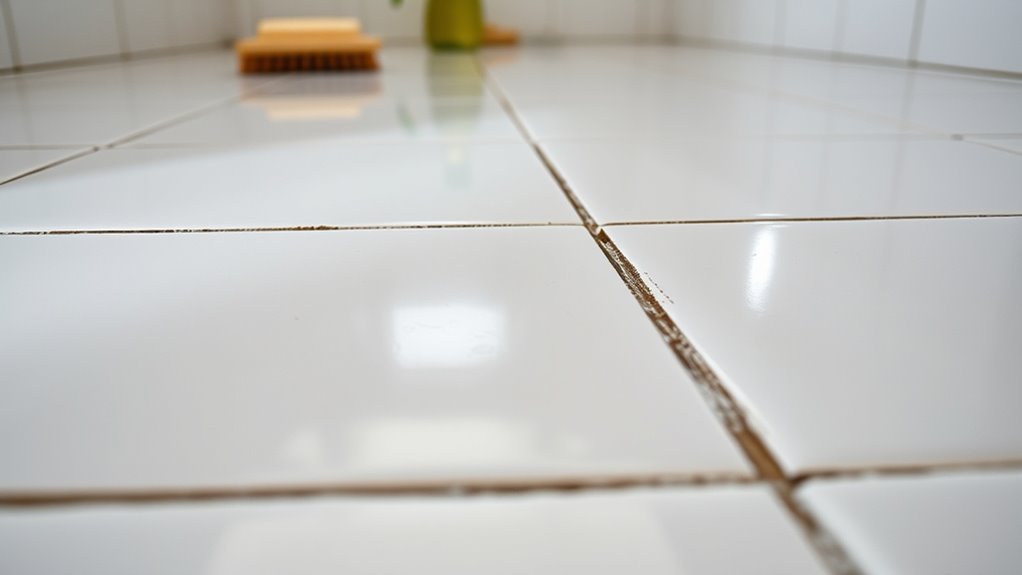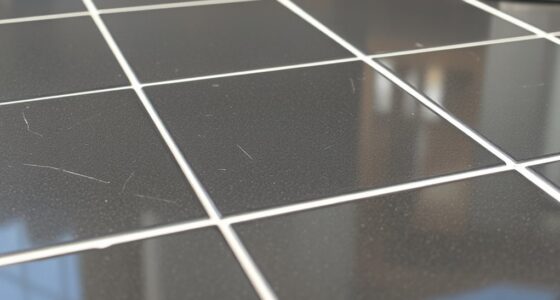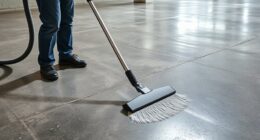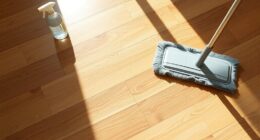Many people make common mistakes when cleaning grout lines, like using harsh brushes, rushing the process, or skipping proper sealing. Over-scrubbing can damage tiles and grout, while neglecting to seal after cleaning lets dirt and moisture seep in. Using the wrong tools or cleaning agents can also cause discoloration or weakening. To keep your tiles looking their best, avoid these pitfalls and discover simple solutions that protect and maintain your grout.
Key Takeaways
- Always thoroughly clean grout before sealing to prevent trapping dirt and moisture, which can cause discoloration or mold.
- Use gentle, appropriate tools like soft brushes or non-abrasive scrub pads to avoid damaging tiles and grout.
- Ensure grout is completely dry before applying sealant to maximize effectiveness and prevent issues like peeling or gaps.
- Follow a consistent maintenance schedule with proper cleaning and sealing to prevent stains, mold, and deterioration.
- Avoid rushing cleaning or applying excessive pressure, which can damage grout and reduce the longevity of your tiled surfaces.
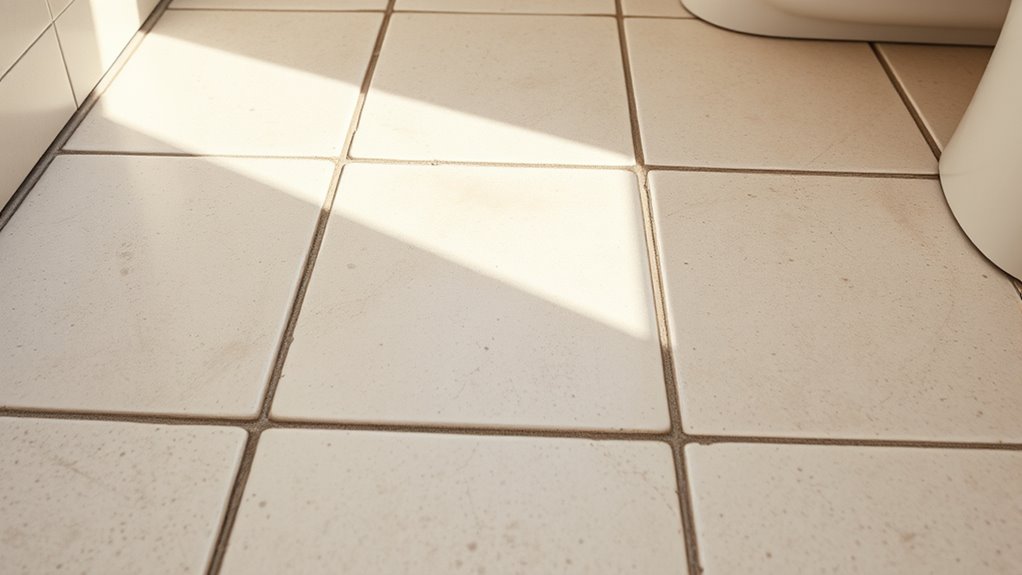
Cleaning grout lines might seem straightforward, but many people make common mistakes that can damage their tiles or make stains worse. One of the biggest errors is neglecting proper sealant application before or after cleaning. Applying a sealant helps protect your grout from future stains and moisture, but if you skip this step or do it improperly, your efforts might be wasted. When applying sealant, verify the grout is thoroughly cleaned and completely dry. Use a quality sealant suited for your tile type, and follow the manufacturer’s instructions carefully. Rushing this process or applying sealant unevenly can lead to gaps, which allow dirt and water to seep in, causing stains and deterioration over time.
Properly sealing grout prevents stains and damage—ensure grout is clean and dry before applying sealant carefully.
Another mistake many make involves cleaning tool selection. Choosing the wrong tools can severely impact your results. For example, using abrasive brushes or steel wool may seem effective at first, but they can scratch or damage delicate tiles and grout lines. Instead, opt for soft-bristled brushes or non-abrasive scrub pads designed specifically for grout cleaning. A grout cleaning brush with small, stiff bristles helps target grime without harming the surface. Also, avoid using overly harsh chemicals or household cleaning agents that aren’t meant for tile grout, as they can weaken the grout or cause discoloration. Instead, select gentle, pH-balanced cleaners formulated for tile and grout.
Many people also overlook the importance of proper cleaning techniques. Over-scrubbing or applying too much pressure can wear down the grout or create uneven surfaces. Instead, use gentle, consistent motions and let your cleaning tools do the work. Pair this with the right cleaner and tools for best results. Additionally, it’s vital to rinse thoroughly after cleaning to remove any residual cleaner or dirt. Failing to do so can leave behind a film that attracts more dirt or causes discoloration. Incorporating proper cleaning techniques aligned with manufacturer instructions can significantly improve your results and preserve your grout’s integrity.
Finally, be mindful of your cleaning schedule. Waiting too long between cleanings allows stains and mold to set deeper into the grout, making them harder to remove. Regular maintenance with proper tools and sealant application keeps your grout lines looking fresh. By avoiding these common mistakes—skipping sealant, choosing inappropriate cleaning tools, and neglecting proper technique—you can protect your tiles and maintain their appearance much longer. It’s a simple process that, when done correctly, saves you time and money while keeping your space looking its best.
Frequently Asked Questions
How Often Should I Clean My Grout Lines?
You should clean your grout lines at least once a month to prevent mold buildup and maintain their appearance. Regular cleaning helps you identify areas needing grout sealing, which protects against stains and moisture. If you notice mold or discoloration, clean immediately. Incorporating grout sealing during your cleaning routine also prevents mold growth long-term and keeps your tiles looking fresh. Consistent maintenance makes grout cleaning easier and more effective.
Can I Use Bleach on Colored Grout?
You can use bleach on colored grout, but it’s risky for color preservation. Bleach may cause staining or fading, ruining your grout’s appearance. Instead, opt for a gentle, pH-neutral cleaner designed for colored grout. For stain removal, use a mixture of baking soda and water or a grout-safe stain remover. Always test in a small area first to confirm it won’t damage or discolor your grout lines.
What’s the Best Way to Prevent Grout Stains?
Think of your grout as a blank canvas—protect it from stains with smart choices. To prevent stains, select the right grout color choices that hide dirt and spills, and employ sealing techniques promptly after installation. Regular sealing acts like armor, shielding your grout from moisture and stains. Avoid neglecting this step, and you’ll keep your grout looking fresh longer, making maintenance easier and your space more beautiful.
Are There Eco-Friendly Grout Cleaning Options?
Yes, you can opt for eco-friendly solutions to clean grout effectively. Look for green cleaning products labeled as biodegradable and non-toxic, or make your own with natural ingredients like baking soda and vinegar. These eco-friendly solutions are safe for your family and the environment, providing a sustainable way to maintain clean grout lines. Regular green cleaning helps prevent stains and keeps your tiles looking fresh without harsh chemicals.
How Do I Fix Damaged or Cracked Grout?
If you ignore cracked grout, it could turn your entire tile into a disaster zone! To fix damaged grout, start with grout repair by carefully removing the cracked sections. Once you’ve cleaned the area, apply new grout, making sure to seal cracked spots properly. Sealing cracked grout prevents moisture from seeping in and causing further damage. Regular maintenance keeps your tiles looking fresh and prevents future issues.
Conclusion
So, next time you’re scrubbing away, remember that your biggest mistake might be just thinking you’re doing everything right. It’s almost funny how easy it is to overlook simple fixes that could save you time and effort—yet here you are, still battling stubborn stains. Irony? The very mistakes you make could be the reason your grout stays stubbornly dirty. But don’t worry; now you’re armed with tips to actually get it right.
